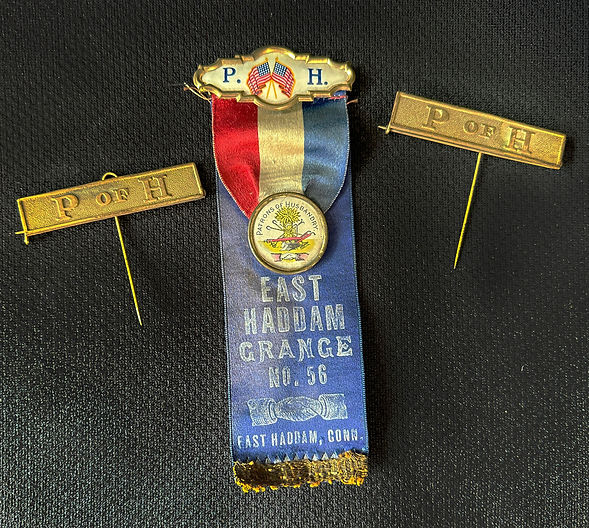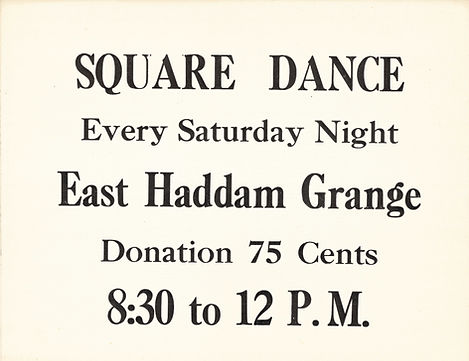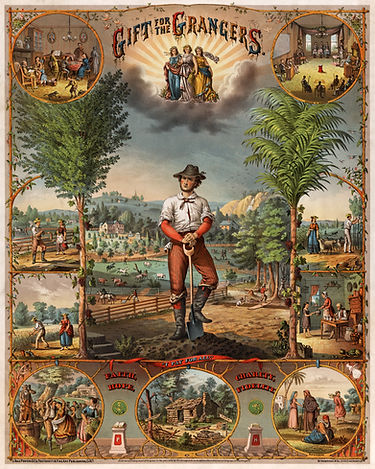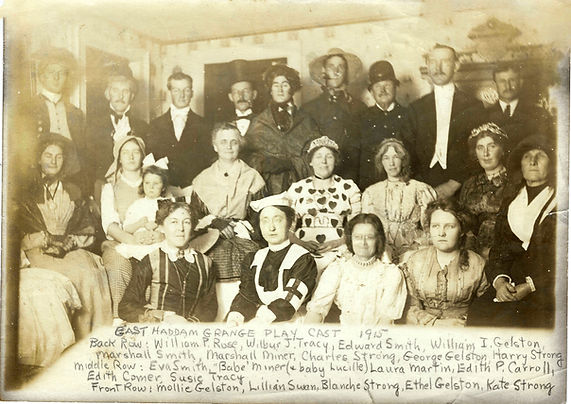
East Haddam Grange No. 56
Learning to Farm Better While Connecting to Your Neighbors
They Were 'Patrons of Husbandry' and a Popular Social Club
By ANITA GELSTON BALLEK
Anita Gelston Ballek (1930-2023) was a local champion of agriculture and the environment. After graduating from the UConn School of Agriculture in 1951, she joined the Grange, following in the steps of her father, brother, and other ancestors. In 1969, she founded Ballek's Garden Center on land her ancestors had farmed since the 1600s.
At about the same time as the Storrs Agricultural School was established in 1881, the national grange movement had taken hold. Land grant colleges such as the Storrs school were a response to farmland being worn out by old practices of tilling without replenishment. They educated students on “progressive agriculture” and how to better deal with worn out agricultural land.
Another problem confronting farm families was a feeling of isolation. The National Grange of the Order of Patrons of Husbandry was founded in 1867 so that farm families could band together for social purposes and learn how to raise their standard of living through better farming methods.
The national Grange and its local chapters also lobbied state legislatures and the U.S. Congress for political goals, including better rail and road transportation and rural free mail
delivery. Our local chapter lobbied for building a bridge connecting Haddam to East Haddam.
Unusual for its time, the Grange encouraged women to join and in fact, required four of the elected positions to be held by women.

In the 1800s, farming was a way of life for many. By mid-century, many farmers faced poverty as the soil became depleted, worn-out from poor crop management. The National Grange of the Orders of Patrons of Husbandry was founded in 1867 to provide education to farmers on modern farming methods, to lobby for farmer-friendly legislation, and to build community through social activities.

Secret Rituals Guided Members
When the Grange first began, it borrowed some of its rituals and symbols from Freemasonry, including oaths and special passwords (originally designed to keep railroad spies out of their meetings).
It also copied ideas from Greek, Roman and Biblical mythology. Small, ceremonial farm tools like scythes were often displayed at Grange meetings. A secret book of ritual was written based on the bible that had to be memorized by officers as they rose up through all the stations of the local chapter, then the Pomona (regional) Granges, then onto the State Grange and finally to the National Grange. My father was being inducted as Master Sea View Pomona Grange on the day that our house burned down in 1925.

The national Grange produced this colorful poster in 1873 that idealized the farmer and promoted the benefits of a farming life. Click on the image to enlarge.
For years, the East Haddam Grange's annual fair was its major fundraiser. The fair booklet was supported with ads for local and area businesses. Click here for a PDF of the 1931 fair booklet.
My grandfather, John Bigelow Gelston, who had traveled the world as an apprentice jeweler to his uncles in New York, was called back to the farm in East Haddam, as the youngest son, to take responsibility for his aging parents. He was appalled at what he found on the “hill” farm. He was gregarious and outspoken, and soon joined a group of other farmers determined to improve their lives by education.
They decided to establish the East Haddam Grange #56, “Patrons of Husbandry” in February of 1889 in a daytime meeting at the Town Hall. The State Master and his wife were to perform the ceremony. They were to arrive by train in Haddam.
Since my Uncle “Todd” Gelston was only 12 (13 was the youngest age inducted), he was sent across the river with horse and wagon to fetch them. He crossed the frozen river with no problem.
Cracking Ice Imperiled the State Master
As the rotund Master and his rotund wile climbed onto the wagon, he heard a crack in the ice. He clicked to get the horses started. They spooked at more cracking to the right and then to the left. He thought to himself, “if I drop the State Master in the river, my father will kill me!”
He quickly eased down and patted their noses to calm them. He carefully led the frightened team across. When the wheels rolled onto the land, he suddenly realized that he was covered with sweat on this chilly morning. He thanked the lord and proceeded to the Town Hall, never revealing his panic to the “precious” cargo.
He vowed not to take the State Master back across until the ice thickened. At age eight, my father’s memory of that time was giving up their bed to the couple and sleeping on the downstairs floor with Uncle Todd next to the fireplace for several days until the ice was safe again.
Every anniversary program, Uncle Todd retold this story. He had a velvet voice and a stirring eloquent delivery that always sent chills through me. He also told of seeing a sledge of lumber and a frantic struggling team of horses go through the ice and into the river as the owner tried desperately to “cut the traces” to save them, almost losing his own life!
Ceremonies Were Central to the Grange
The founders crafted a beautiful ritual. When committed to memory and delivered eloquently, it was thrilling to listen to. My father struggled to memorize it, but once he did, his delivery was wonderful.
In the short days of winter, l often held the lantern and the cows’ tails as he drum, drum, drummed the milk into the pail and recited his part over and over as he milked with his head stuck in the cow's flank. (Later, l learned all the parts; it came easily to me as I had heard them all when l was age five and six.
The Grange was a secret organization. if you came late to a meeting, you had to give the special knocks to alert the gatekeeper and the special password to give at the inside door. If the password was forgotten, the steward would give a signal and say, “worthy master, a patron without the word," and he would reply “assistant stewards, please escort him to my station.”
Phil Daniels and l were the assistant steward and lady assistant steward. We took our staves from their heavy metal bases, shouldered them and marched to the door (to the accompaniment of the pianist). The patron followed us as we marched on the runner rug around the perimeter of the room, making “military corners” and separating before the master to present him.

Putting on plays and presentations were among the chapters many activities designed to foster community connections. The cast of this 1915 play consisted of chapter members.
After the master whispered the “word,” the pianist continued and we marched him to the nearest empty chair, the music continuing until we had poled our staves and took our seats.
To join the grange a member sponsor was needed. An inspection team was assigned to arrive unannounced at the prospective member’s farm. They inspected the barns, the livestock, and the fields for health and cleanliness. The women would hope to find a clean house, well-fed children, a neat herb and vegetable garden, and a contented poultry flock.
The report came back at the next meeting. The members at large would then vote using a box with while balls and black. One black ball would require a re-vote. The master would admonish the members to be careful.
In all the years of voting, I saw only one black ball to stand. A black-bailed family had a second chance to bring their standards up to try for a second inspection. This method certainly raised the living standard many notches. Every family wanted to join mainly for the fun and entertainment to fill their bleak lives.
The “Lecturer” was the station that planned the programs. Half an hour was given to information on better practices. The lecturer attended training sessions and reported the findings. Sometimes experts would be engaged as speakers. The other half hour (or more) was devoted to fun. Much latent talent was revealed: barbershop quartets; bands with musical saws, harmonicas, fiddles, etc; skits and tableaus; comical and serious elocution; and of course stirring solo voices. Sometimes, the rugs, stations, and bible stands were put away for square and round dancing.
Years of Expansion and an Annual Fair
The Grange Fairs were started then, which proved to be a good way to raise money. A large basement room was added, allowing over 100 people to be seated for a sit-down dinner. An annual June “Dairy Supper” continued to flourish well into the early 1970s. Our contribution was always homemade hand-cranked ice creams, in three different flavors.
Finally, the upstairs hall was completed in 1922, with a mortgage taken. When it was paid off, a ceremony was held, the mortgage burned, the ashes kept in a vial. A box frame hung on the wall with the vial and a replica of the mortgage to remind us all of the hard work it took to have this beautiful hall. In 1928, an addition was built onto the rear of the building to provide dressing rooms and modern plumbing and toilet facilities.
The Grange Fair continued until the early 1930s, when polio decimated the Hoffman family. Mary Ballek Hoffman was manning her “raised and filled” donut booth with her four children in attendance. Her oldest daughter died from the disease, her middle two had mild cases, and her youngest was in an “iron-lung” for months with braces and crutches for life. The fair was discontinued in the wave of fear that followed.

Men and women dressed in their finery and exhibited their cattle during the 1908 Grange Fair Day on Town St. in front of the Grange building and town meeting hall.

The East Haddam Town Hall and Grange during the celebration of the "raising up" of the Grange in 1922. Before the new upper story was built, the Grange operated from the cellar or walk-out basement of their building.
World War II claimed most of the healthy farmers in town, leaving widows, wives, and a few old, 2-A (deferred for national health or interest) or 4-F men. Ted Stout valiantly held the Grange together. l joined in 1943 and was instantly placed as Lady Assistant Steward. We continued as best we could with no gas, no tires, and even little or no sugar for cakes, as all were rationed!
When the war ended, there was an upsurge in attendance, many meetings needing extra chairs, brought up from the basement. The apex year was in 1954 when l became Master (the sixth Gelston in that position). The repressed talent unused during the war blossomed. The lecturer’s programs were outstanding. We hired a bus and took our programs to other Granges on Mystery Rides in a hired 45-passenger bus. We also hosted Mystery Rides of other Granges.
Our entertainment included competitive programs. The A-M men teamed up with N to Z women and vice-versa. Rehearsals were secretly held. An outside team of judges would critique the performances and proclaim the winner. The losing team were required to provide an outstanding meal and serve it to the victors.
One program that was always successful was the Children's Christmas Presentation. Every year, children would practice for months to perform a song or a recitation on stage in order for Santa to give them a present (secretly provided by parents) at the ensuing Christmas Party.
When my son Bob was four years old, my mother still lived with us. She babysat while we were out milking. We had a TV and Davy Crockett “Born on the Wild Frontier” was on every afternoon. She encouraged him to learn all 17 verses of this song. When it was his turn, at the Christmas Program, he walked on stage with his chaps, his guns, and his coonskin cap and started to belt out the song in a clear, strong voice, as my mother played the piano. I was surprised and proud — until it went on and on. I tried to signal him that it was enough. He thought l was urging him on. I watched as the audience rolled their eyes with impatience and disbelief. Finally, when he finished, they stomped and clapped, glad to have it over. He and my mother were oblivious. l couldn’t burst their bubble, although l did insist on critiquing next year's performance.
Albert Halls’ red-haired daughter and a friend of hers always recited in unison, “T’was the Night Before Christmas.” Others tap-danced, sang solos, or group-sang carols. My mother played for everyone who needed accompaniment. The Grange provided a little box with a handle of hard candies. I would hoard mine for months.
A Matter of Degrees
Part of their extensive and beautiful ritual was an induction ceremony. There are seven degrees of Grange membership. The ceremony of each degree relates to the seasons and various symbols and principles. The local chapter performed the first four Degrees. The Regional Chapter performed the Fifth Degree, the State Chapter the Sixth Degree, and finally the National Grange performed the Seventh Degree. During my induction, six of us traveled to Burlington, VT, to receive the Seventh degree.
We had talented memorizers and orators in our midst. We formed a traveling “degree team” including George Comer, Mortimer Gelston, Phil Daniels, me, and others. We came to the aid of other Granges. The ritual was so beautiful it would have been a shame to stumble or mumble when our orators were expected to thrill the new members. Every one of us knew all the parts. If a new member of our team hesitated, we could quietly whisper the next words to continue. l thrilled to these words no matter how many times l heard them.
We also formed a drill team. As the assistant stewards, Phil Daniels and l would shoulder our staffs and lead our eight marchers and (a few more from the host Grange if they desired) in intricate patterns. We all dressed in white and blue, wearing our gold trimmed blue sashes to the marching tunes of our pianist.
In 1955-56, two factors caused a sudden steep decline in attendance: Almost everyone acquired a television for entertainment and changing economics drove all the small farmers out of business.
The latter happened when government authorities required the largest milk buyers to have a bulk tank for storage and also decreased volume accepted from farmers.
Our 100 farmers quickly became 20. When Sprecher Dairy, a large producer and buyer, went out of business (they accepted one or two cans from small farmers) only four large farms remained.
After 106 years of activity, the East Haddam Grange finally disbanded on January 4, 1995, leaving an empty hall. The local Lions Club bought the building, later deeding it to the town.
Meet the East Haddam Grange No. 56 Masters
These Masters of the Town Grange Led Meetings and Ceremonies
Part of an 1873 image by the National Grange of the Order of Patrons of Husbandry
















